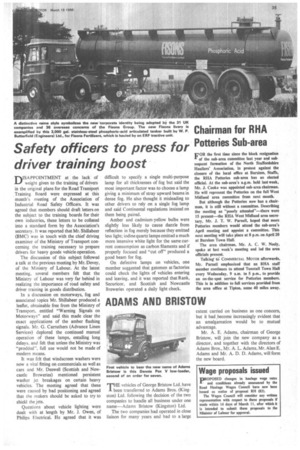Safety officers to press for driver training boost
Page 37

If you've noticed an error in this article please click here to report it so we can fix it.
rySAPPOI NT MEN T at the lack of weight given to the training of drivers in the original plans for the Road Transport , Training Board were expressed at this month's meeting of the Association of Industrial Road Safety Officers. It was agreed that members should draft letters on the subject to the training boards for their own industries, these letters to be collated into a standard form by the Association's secretary. It was reported that Mr. Shillabeer (BMC) was in touch with the chief driving examiner of the Ministry of Transport concerning the training necessary to prepare drivers for heavy goods vehicle operation.
The discussion of this subject followed a talk at the previous meeting by Mr. Devey, of the Ministry of Labour. At the latest meeting, several members felt that the Ministry of Labour was very far behind in realizing the importance of road safety and driver training in goods distribution.
In a discussion on motorways, fog and associated topics Mr. Shillabeer produced a leaflet, obtainable free from the Ministry of Transport, entitled "Warning Signals on Motorways" and said this made clear the exact applications of the amber flashing signals. Mr. G. Carruthers (Advance Linen Services) deplored the continued manual operation of these lamps, entailing long delays, and felt that unless the Ministry was "prodded-, full use would not be made of modern means.
It was felt that windscreen washers were now a vital fitting on commercials as well as cars and Mr. Deswell (Scottish and Newcastle Breweries) mentioned persistent washer jet breakages on certain heavy vehicles. The meeting agreed that these were caused by bad positioning and agreed that the makers should be asked to try to shield the jets.
Questions about vehicle lighting were dealt with at length by Mr. J. Owen, of Philips Electrical. He agreed that it was difficult to specify a single multi-purpose lamp for all thicknesses of fog but said the most important factor was to choose a lamp giving a minimum of stray upward beams in dense fog. He also thought it misleading to other drivers to rely on a single fog lamp and said Continental regulations insisted on them being paired.
Amber and cadmium-yellow bulbs were slightly less likely to cause dazzle from reflection in fog merely because they emitted less light; iodine quartz lamps emitted a much more intensive white light for the same current consumption as carbon filaments and if properly focused and "cut off" produced a good beam for fog.
On defective lamps on vehicles, one member suggested that gatemen at factories could check the lights of vehicles entering and leaving, and it was reported that Rank, Securicor. and Scottish and Newcastle Breweries operated a daily light check.




































































































































































